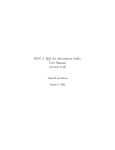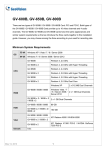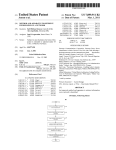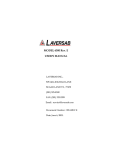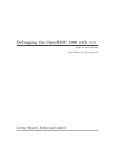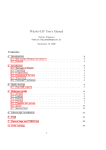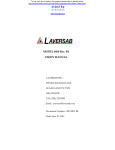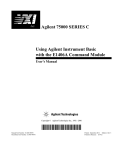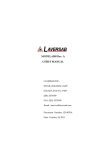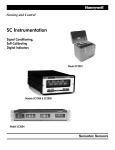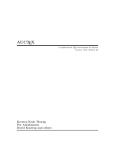Download DVII: A TEX dvi information utility User Manual (version 0.44)
Transcript
DVII: A TEX dvi information utility User Manual (version 0.44) Adam H. Lewenberg May 4, 2002 Contents 1 Introduction 3 1.1 Design Goals . . . . . . . . . . . . . . . . . . . . . . . . . . . . . 3 1.2 Some examples of use . . . . . . . . . . . . . . . . . . . . . . . . 4 1.2.1 Basic usage . . . . . . . . . . . . . . . . . . . . . . . . . . 4 1.2.2 Display a summary of information . . . . . . . . . . . . . 4 1.2.3 List all information . . . . . . . . . . . . . . . . . . . . . . 5 The dvii home page . . . . . . . . . . . . . . . . . . . . . . . . . 5 1.3 2 Installing 6 2.1 Where to get executables . . . . . . . . . . . . . . . . . . . . . . 6 2.2 Where to get the source code . . . . . . . . . . . . . . . . . . . . 6 3 All the command line options 7 3.1 -c: perform simple validity check . . . . . . . . . . . . . . . . . . 7 3.2 -C: perform more rigorous (and slower) validity check . . . . . . 7 3.3 -d: dump opcodes . . . . . . . . . . . . . . . . . . . . . . . . . . 8 3.4 -f: display fonts . . . . . . . . . . . . . . . . . . . . . . . . . . . 8 3.5 -F: display fonts on each page . . . . . . . . . . . . . . . . . . . . 9 3.6 -g: suppress control characters when showing special text . . . . 9 3.7 -h: show main help screen . . . . . . . . . . . . . . . . . . . . . . 10 3.8 -H: show options help screen . . . . . . . . . . . . . . . . . . . . . 11 3.9 -m#: add message digest information when displaying pages . . . 11 3.10 -M#: add message digest information but ignore certain opcodes . 11 3.11 -n#: display # bytes of special text . . . . . . . . . . . . . . . . . 13 1 CONTENTS 2 3.12 -p: display page information . . . . . . . . . . . . . . . . . . . . 13 3.13 -P: suppress the display of physical pages . . . . . . . . . . . . . 14 3.14 -s: display specials . . . . . . . . . . . . . . . . . . . . . . . . . . 14 3.15 -S: count number of specials . . . . . . . . . . . . . . . . . . . . . 15 3.16 -T: give timing information . . . . . . . . . . . . . . . . . . . . . 15 3.17 -u: display summary . . . . . . . . . . . . . . . . . . . . . . . . . 16 4 Pages 17 4.1 17 Physical pages versus TEX pages . . . . . . . . . . . . . . . . . . 5 Fonts 18 6 Specials 19 7 Message digest 20 7.1 What is a message digest? . . . . . . . . . . . . . . . . . . . . . . 20 7.2 Why use a message digest with TEX? . . . . . . . . . . . . . . . . 21 A Acknowledgements 23 B Source files 24 C Perl scripts 26 C.1 fontdiff.pl . . . . . . . . . . . . . . . . . . . . . . . . . . . . . 26 C.1.1 Introduction . . . . . . . . . . . . . . . . . . . . . . . . . 26 C.1.2 How are fonts “different”? . . . . . . . . . . . . . . . . . . 27 C.2 specials.pl . . . . . . . . . . . . . . . . . . . . . . . . . . . . . 28 C.3 details.pl . . . . . . . . . . . . . . . . . . . . . . . . . . . . . . 29 Chapter 1 Introduction dvii is a utility written in C that extracts information from a TEX dvi file. Information displayed can include a summary: • File comment (usually the date the file was compiled) • File size • Number of (physical) pages • Number of fonts as well as more detailed information: • Font names for all fonts used • List of physical page number/TeX page number pairs • List of all \specials and the page on which they appear • List of all fonts used on a given page For example, running the command dvii -u test.dvi generates the summary File size: 1500 bytes (1 K) Comment string: TeX output 1999.12.05:1951 Page count: 6 Number of fonts: 3 1.1 Design Goals I have designed this utility with the following goals in mind: 3 CHAPTER 1. INTRODUCTION 4 1. It should be fast, faster than dvitype. 2. It should be easy to use the output as a back end to PERL, enabling the easy manipulation of the data for more specific purposes. 3. It should be useful to the TeX community. 4. It should be portable. In light of these goals, I encourage all those who use it to send me bug reports, comments, and suggestions on how it can be improved. I can be reached at [email protected]. In particular, I am interested in making this program compile on as many different platforms as possible, so if you have compiling problems, please let me know. 1.2 Some examples of use The following examples use the file test.dvi whose source can be found in Appendix B. 1.2.1 Basic usage The syntax for use is dvii [options] dvifile where dvifile is the name of the dvi file that you want information about. You can leave off the extension dvi; thus, dvii test and dvii test.dvi are equivalent. (Unless you also have a file named simply test in which case dvii will complain that test is not a valid dvi file. In such cases, be sure to explicitly supply the extension .dvi.) 1.2.2 Display a summary of information dvii -u test.dvi File size: 1500 bytes (1 K) Comment string: TeX output 1999.12.05:1951 Page count: 6 Number of fonts: 3 The summary tells us: the dvi file test.dvi is 1500 bytes long (roughly 1 kilobyte), was compiled on December 5, 1999 at 7:51 PM, has 6 pages, and contains 3 fonts. CHAPTER 1. INTRODUCTION 1.2.3 5 List all information dvii test.dvi File size: 1500 bytes (1 K) Comment string: TeX output 1999.12.05:1951 Page count: 6 Number of fonts: 3 f:[50/cmr10/1200]::4bf16079 f:[23/cmbx10/1000]::1af22256 f:[0/cmr10/1000]::4bf16079 p:[1/1] p:[2/2] p:[3/3] p:[4/4] p:[5/-1] p:[6/-3] s:[2/2]:: A short special s:[3/3]:: abcdefghijklmnopqrstuvwxyzABCDE... s:[4/4]:: PSfile 1.eps s:[4/4]:: PSfile 2.eps s:[4/4]:: PSfile 3.EPS s:[4/4]:: PSfile dog1.gif s:[4/4]:: PSfile cat.eps s:[6/-3]:: Some control characters: [] With no options, dvii first displays a summary of the dvi file (see section 1.2.2). The next 3 lines list the three fonts used by the dvi file. The succeding 6 lines list page information. The format p:[m/n] means that this is physical page m corresponding to TEX page n. The physical page is the page in the order that it would be displayed or printed out on a printer. The TEX page is the page number that would appear (in normal circumstances) at the bottom of the page. For more on the difference between physical and TEX pages, see section 4.1. The last 6 lines list all the \special’s included in the dvi file. Note that not every dvi file will contain \special’s. The format is the same as that for pages; the text following the double colon :: is the first 128 bytes of the \special text. 1.3 The dvii home page The dvii home page can be found at http://www.macrotex.net/dvii/dvii.html Chapter 2 Installing To install, copy the file dvii (or, in the DOS/Windows environment, the file dvii.exe) to a directory in your PATH. To uninstall, remove the file dvii from whereever you put it. 2.1 Where to get executables You will find several executables at the dvii home page. Currently, there are executables for the MS-DOS, Windows 95/98/ME/NT/2000, Linux, and Solaris (Sparc and Intel) platforms. Please let me know of any that do not work. After you download the executable, you need to rename the file to dvii.exe (under DOS or Windows), or dvii (under Unix), and place it somewhere in your PATH. 2.2 Where to get the source code dvii is written in portable C code whose source is a single file named dvii.c. It should compile on any system with an ANSI C compiler. To get the source file, go to the dvii home page at www.macrotex.net/dvii/dvii.html. 6 Chapter 3 All the command line options 3.1 -c: perform simple validity check The -c option does a simple validity check of the dvi file: (a) the first two bytes should be 247 2, (b) there should be at least four 233’s at the end of the file immediately preceded by a 2. This is not much of a check: it will certainly not catch dvi files whose middle bytes have become corrupted, but it will at least catch files that are clearly not dvi files (such as text files). Note that the -c option is implicit in almost every other option, so its main use is to detect files that are probably not dvi files. Ses section 15 of dvitype.web for more information. Example of use: dvii -c test.dvi dvi file ’test.dvi’ passed validation check (level 0). 3.2 -C: perform more rigorous (and slower) validity check (Note: this is a capital ’C’.) This command causes dvii to traverse the entire dvi file parsing each opcode. If the dvi file is corrupted, this command will detect it. 7 CHAPTER 3. ALL THE COMMAND LINE OPTIONS 8 However, you pay for this: -C is much slower than -c. dvii -C test dvi file ’test.dvi’ passed validation check (level 1). 3.3 -d: dump opcodes (This option is available in version 0.42 and later.) This option (which implies the -C option) displays all the opcodes to printed starting with pre. Here is a sample: dvii -d test o:247 o:139 o:141 o:159 o:142 ... o:248 dvi file ’test.dvi’ passed validation check (level 1). where ... are many opcodes. The script details.pl uses this mode to create an opcode summary of the file; see section C.3 for more information on details.pl. 3.4 -f: display fonts If you want to list all the fonts used in a dvi file, use the -f option. Note that different sizes of the same font will list separately. dvii -f test f:[50/cmr10/1200]::4bf16079 f:[23/cmbx10/1000]::1af22256 f:[0/cmr10/1000]::4bf16079 The file test.dvi calls 3 fonts: font number 50 is cmr10 at size 1200, font number 23 is cmr10 at size 1000, and font number 0 is cmbx10 at size 1000. (For more information on fonts, see chapter 5.) CHAPTER 3. ALL THE COMMAND LINE OPTIONS 3.5 9 -F: display fonts on each page This option (which implies the -p and -f options) lists the fonts used on each page. dvii -F test f:[50/cmr10/1200]::4bf16079 f:[23/cmbx10/1000]::1af22256 f:[0/cmr10/1000]::4bf16079 p:[1/1] start of font list Font [0/cmr10/1000] end of font list p:[2/2] start of font list Font [0/cmr10/1000] end of font list p:[3/3] start of font list Font [0/cmr10/1000] Font [23/cmbx10/1000] end of font list p:[4/4] start of font list Font [0/cmr10/1000] end of font list p:[5/-1] start of font list Font [0/cmr10/1000] Font [50/cmr10/1200] end of font list p:[6/-3] start of font list Font [0/cmr10/1000] end of font list 3.6 -g: suppress control characters when showing special text The -g option can be used when displaying \special information. If a \special contains text with unprintable characters, it may corrupt some computer screens. So, instead of trying to print these unpleasant characters, dvii will instead print a ‘.’. CHAPTER 3. ALL THE COMMAND LINE OPTIONS 10 Here is what the \special text looks like without the -g option: dvii -s test.dvi s:[2/2]:: A short special s:[3/3]:: abcdefghijklmnopqrstuvwxyzABCDE... s:[4/4]:: PSfile 1.eps s:[4/4]:: PSfile 2.eps s:[4/4]:: PSfile 3.EPS s:[4/4]:: PSfile dog1.gif s:[4/4]:: PSfile cat.eps s:[6/-2]:: Some control characters: [] (Note: there are four control characters between the square brackets; because TEX does not like these particular characters, you cannot see them here.) Now with the -g option: dvii -s -g test.dvi s:[2/2]:: A short special s:[3/3]:: abcdefghijklmnopqrstuvwxyzABCDE... s:[4/4]:: PSfile 1.eps s:[4/4]:: PSfile 2.eps s:[4/4]:: PSfile 3.EPS s:[4/4]:: PSfile dog1.gif s:[4/4]:: PSfile cat.eps s:[6/-2]:: Some control characters: [....] 3.7 -h: show main help screen This option shows the main help screen which begins dvii -h This is dvii 0.?? (DVI file information) by Adam Lewenberg Send bug reports to [email protected] dvii -h (Print help screen) dvii dvifile (Print dvi information) dvii [many possible options] dvifile -------------------------------------------H : show complete list of options -h : show this help screen -u : display dvi summary CHAPTER 3. ALL THE COMMAND LINE OPTIONS 11 ... etc. 3.8 -H: show options help screen This option displays all the command line options: dvii -H All the command line options: -c : perform simple validity check -C : perform more rigorous (and slower) validity check -f : display fonts ... etc. 3.9 -m#: add message digest information when displaying pages (See Chapter 7 on message digests.) Display a 16-byte message digest for each page. dvii -m test [message digest: simple sum] p:[1/1]::D8C977816A091771A3A631E7592DAE6D p:[2/2]::16E5A31EF87F926DB1F86CAD165C5453 p:[3/3]::1139D12267E3D60267CC788905909170 p:[4/4]::68E5A2E9D7320743CB85769CAAE9B023 p:[5/-1]::DE72BC3345FFDF7E779C8C667DCE3F97 p:[6/-3]::12808C9489FD3430C3C8EDAD8A4EC760 3.10 -M#: add message digest information but ignore certain opcodes (See Chapter 7 on message digests.) Display a 16-byte message digest for each page, but ignore certain dvii opcodes. Depending upon the value of #, certain of the dvi information will be ignored when computing the message digest. CHAPTER 3. ALL THE COMMAND LINE OPTIONS 12 -M0 Do not ignore any of the opcodes; equivalent to -m. -M1 Ignore all font assignments and font definitions. -M2 Ignore all NOPS (no ops). -M4 Ignore all \special’s. -M8 Ignore all pushes and pops. These options can be combined by adding; for example, to ignore fonts and \special’s, use -M5. A rationale as to why you might want to ignore certain dvii page information when computing a message digest follows. If you use page message digests to detect when a page has changed, you may get false alarms when the only thing that changes in the dvi file is the order of font definitions: the page looks the same but will have a different message digest because the message digest has changed. For example, consider the two files % File A \font\a=cmr10 at 11pt \font\b=cmr10 at 12pt \a A \b A \end % File B \font\b=cmr10 at 12pt \font\a=cmr10 at 11pt \a A \b A \end These two files generate identical looking output but different dvi code because the font numbering is different. If you use dvii -m you will see different fingerprints: [message digest: simple sum] A: p:[1/1]::6676847979940C046D093C93789A1812 B: p:[1/1]::6676837979940B056D093C94789A1812 ^ But, if you use dvii -M1 you get [message digest: simple sum (ignore font)] A: p:[1/1]::B42E10A601774236B86D11CE2F8C25E4 B: p:[1/1]::B42E10A601774236B86D11CE2F8C25E4 By examining the fonts with the -f option you can see where the two dvi files differ: dvii -f filea f:[51/cmr10/1200]::4bf16079 f:[50/cmr10/1100]::4bf16079 f:[0/cmr10/1000]::4bf16079 dvii -f fileb f:[51/cmr10/1100]::4bf16079 f:[50/cmr10/1200]::4bf16079 f:[0/cmr10/1000]::4bf16079 CHAPTER 3. ALL THE COMMAND LINE OPTIONS 13 The font cmr10 at 1200 is font 51 in filea, whereas it is font 50 in fileb. 3.11 -n#: display # bytes of special text Normally, dvii -s test will display a maximum of 128 bytes of the \special text. For example, let filec.tex be the file \special{0123456789abcdefghijklmnopqrstuvwxyzABCDE...} \bye (Note that the ’...’ indicates more special text which we omit due to space limitations in this manual.) dvii -s filec s:[1/1]:: 0123456789abcdefghijklmnopqrstuvwxyzABCDE... However, you can tell dvii how many bytes to display by using the -n option: dvii -s -n20 filec s:[1/1]:: 0123456789abcdefghij Finally, if you want to display all the \special text, use -n-1: dvii -s -n-1 test s:[1/1]:: 0123456789abcdefghijklmnopqrstuvwxyzABCDE... Here, the output of dvii -s -n-1 test looks like dvii -s test only because we do not have enough page to show the entire \special text, but believe me, dvii -s -n-1 test will display all the \special text. 3.12 -p: display page information To display a list of physical page/TEX page pairs, use the -p option: dvii -p test p:[1/1] p:[2/2] p:[3/3] p:[4/4] p:[5/-1] p:[6/-3] CHAPTER 3. ALL THE COMMAND LINE OPTIONS 14 The first number indicates the physical page and the second number indicates the TEX page. For example, the sixth physical page has TEX page −3. For more information on the difference between physical pages and TEX pages, see section 4.1. 3.13 -P: suppress the display of physical pages (This option is available in version 0.43 and later.) This option only makes sense when you are listing page information (e.g., when using the -p or the -M option. Here is what you get with dvii -p test: dvii -p test p:[1/1] p:[2/2] p:[3/3] p:[4/4] p:[5/-1] p:[6/-3] and here is what you get when you add the -P option: dvii -p -P test p:[XX/1] p:[XX/2] p:[XX/3] p:[XX/4] p:[XX/-1] p:[XX/-3] So, why might you want to do something so silly? This is most useful when usnig the message digest feature to detect page changes (see Chapter 7). Imagine that you have message digest information for your entire 1000-page book. Later, you compile only one chapter. If you create a message digest of the chapter, the physical pages will no longer agree with the message digest for the entire book. So, suppressing the physical pages is the only way you can reliably tell if there has been a change. 3.14 -s: display specials The -s lists each \special in the file and the page on which it appears. For example: CHAPTER 3. ALL THE COMMAND LINE OPTIONS 15 dvii -s test s:[2/2]:: A short special s:[3/3]:: abcdefghijklmnopqrstuvwxyzABCDE... s:[4/4]:: PSfile 1.eps s:[4/4]:: PSfile 2.eps s:[4/4]:: PSfile 3.EPS s:[4/4]:: PSfile dog1.gif s:[4/4]:: PSfile cat.eps s:[6/-3]:: Some control characters: [] Thus, there is a \special on (physical) page 2 consisting of the text ‘A short special’. The \special text on page 6/-3 contains some control characters which do not show up on the printed page because they do not correspond to any printable characters. (Actually, the text is [^A^B^C^D].) 3.15 -S: count number of specials Normally, the summary that the -u option generates includes the number of pages and the number of fonts, but not the number of specials. If you want a count of the number of specials, use -S; note that -S implies -u dvii -S test File size: 1500 bytes (1 K) Comment string: TeX output 2001.01.25:0933 Page count: 6 Number of fonts: 3 Number of specials: 8 3.16 -T: give timing information To see how long dvii took to run, use the -T option: dvii -T -C test dvi file ’test.dvi’ passed validation check (level 1). User time: 0.0 seconds Real time: 0.0 seconds The ‘User time’ is the time external to the computer to run; that is, if you started a stopwatch before executing the command and then stopped it after the command finished, the elapsed time corresponds to the ‘User time’. CHAPTER 3. ALL THE COMMAND LINE OPTIONS 16 On the other hand, most modern operating systems are capable of running many programs at once, switching from one to the other. So, while it may appear to you that a command takes 5 minutes to run, the computer itself may have only spent 1 minute of the 5 minutes on your program, spending the other 4 minutes on other tasks. Hence, 1 minute would be ‘Real time’. If the file is small enough (as it is in the cast of test.dvi above), you may see both times listed as 0.0 seconds. 3.17 -u: display summary To display a summary of a dvi file, use the -u option: dvii -u test.dvi File size: 1500 bytes (1 K) Comment string: TeX output 1999.12.05:1951 Page count: 6 Number of fonts: 3 The summary tells us: the dvi test.dvi file is 1500 bytes long (roughly 1 kilobyte), was compiled on December 5, 1999 at 7:51 AM, has 6 pages, and contains 3 fonts. See also the -S option. Chapter 4 Pages 4.1 Physical pages versus TEX pages Every time TEX writes a page to a dvi file it inserts codes indicating the beginning (BOP) and end (EOP) of the page. The number of physical pages is thus the number of BOP’s in the dvi file. At the start of each physical page, TEX records additional information indicating what page number will appear when the dvi file is printed. (More precisely, it stores the contents of the first ten \count registers, the first of which is usually the register used to store the page number printed at the bottom of the page.) This page number is the TEX page. Thus, it is possible to have a dvi file that when printed consists of 10 physical pieces of papers where each page has the number ’1’ printed at the bottom of the page. For example, the file test.dvi consists of 6 physical pages, with TEX page numbers 1, 2, 3, 4, −1, −3. dvii -p test p:[1/1] p:[2/2] p:[3/3] p:[4/4] p:[5/-1] p:[6/-3] The first number in the bracket is the physical page while the second is the TEX page. If you want to suppress the display of physical pages, use the -P option (see section 3.13). 17 Chapter 5 Fonts Internally, TEX refers to each font via a font number. Each font number corresponds to an external font name and a scaling factor. For example, the file test.dvi calls upon 3 fonts: fonts 0, 23, and 50. In this case, font 0 refers to a font named cmr10 scaled at magnification 1000. dvii ouputs font information in the following format: f:[n/filename/scale]::checksum The n refers to the font number (e.g., 0), filename refers to the external file name (e.g., cmr10), scale refers to the scaling factor (e.g., 1000), and checksum to the checksum of the font’s TFM file (e.g., 4bf16079). Here are the fonts in test.dvi as displayed by dvii: dvii -f test f:[50/cmr10/1200]::4bf16079 f:[23/cmbx10/1000]::1af22256 f:[0/cmr10/1000]::4bf16079 Note that TEX views two fonts with the same external fontname but with different scaling factors as different fonts. 18 Chapter 6 Specials As not every publishing feature is built-in to TEX, the creator of TEX, Donald E. Knuth, made sure that a facility to insert “hooks” into a dvi file was available. These hooks are called specials and are invoked via tha \special command. For example, if you put the command \special{Hello} in a TEX file, the resulting dvi file will contain a \special opcode with argument Hello. TEX postprocessors (such as dvi viewers or printer drivers) can then interpret the \special’s and take the appropriate action. One of the more common uses of the \special is to insert figure files into a TEX document. For example, the LATEX graphics package provides the \includegraphics command which will take as an argument the name of figure file and place a \special command in the dvi file listing the name of the file, its dimensions, and other information. Altough TEX itself knows nothing about figure files, most dvi printer drivers (such as dvips) know how to interpret the \special information and will insert the figure. You can tell dvii to go through a dvi file and list the location and contents of each \special. This can be useful, for instance, if you want to see on which page a particular figure appears without actually viewing or printing the file. dvii -s test s:[2/2]:: A short special s:[3/3]:: abcdefghijklmnopqrstuvwxyzABCDE... s:[4/4]:: PSfile 1.eps s:[4/4]:: PSfile 2.eps s:[4/4]:: PSfile 3.EPS s:[4/4]:: PSfile dog1.gif s:[4/4]:: PSfile cat.eps s:[6/-3]:: Some control characters: [] 19 Chapter 7 Message digest 7.1 What is a message digest? A short answer: a message digest is a numerical summary or “fingerprint” of a given set of data (such as a data file or e-mail message). A longer answer. A computer file is really just a sequence of numbers. For example, the file containing the single word “Hello” is really just the the sequence 72 101 108 108 111. The file containing the file “Goodbye” is the sequence 71 111 111 100 98 121 101. Of course, most computer files are much bigger with correspondingly longer sequences. Imagine that a file with one million characters needs to be sent from one computer to another computer thousands of miles away. How can the recipient be assured that the data received is in fact the data that was sent? One way would be to send the data twice and compare the two transmissions. This might work, but would be rather slow: it would take twice as long to send the message twice. So, instead of sending the message again a second time we send a shorter message that gives a summary of the original message. This summary is calculated at both ends, and the receiver compares her summary with the one sent by the transmitter. If they match, this is evidence that the file was received intact. Of course, the form of this summary will affect how reliable the summary is at detecting if the data was sent correctly. One sort of summary is called a parity check : add up all the numbers in the file and see if this sum is odd or even. The message digest is then either 0 (if the sum is even) or 1 (if the sum is odd). As you may imagine, this form of fingerprint is not very useful when the files get long. Thus one desirable aspect of a message digest is that different data sets which differ in a small number of places generate different message digests. This way, 20 CHAPTER 7. MESSAGE DIGEST 21 changes to the data are readily detected. One system that does this well is the MD5 message digest. It is “cryptographically secure”, that is, if one file generates a given MD5 message digest, it is hard to construct a different file with the same MD5 message digest. Thus, it is suitable for “digital signatures” that are hard to forge. 7.2 Why use a message digest with TEX? The last (and often trickiest) step in setting a book is “page layout”. In the TEX world this corresponds to optimizing figure placement and fixing bad page breaks. This is often delicate: changing one line of text can change not just the page on which the line appears, but the pages following (“text reflow”). Thus, it would be very nice to determine, after making a small change, which pages have changed. One way to determine this is to look at a printout of each page and see which pages have changed. This, however, is not very practical except for the smallest documents. My approach is to take each page’s “finger print” (via a message digest) before making a change, make the change, and then take each page’s fingerprint again after making the change. Then, just check which pages’ fingerprints have changed. Here is an example. Let filex.tex contain the following source: a\eject b\eject c\eject d\eject e\eject f\end The summary of this file is dvii -u filex File size: 628 bytes (1 K) Comment string: TeX output 1999.12.17:0937 Page count: 6 Number of fonts: 1 We can save and display the page information along with a message digest of each page if we use the -M1 option: dvii -p -M1 filex > before.md cat before.md [message digest: simple sum (ignore font)] p:[1/1]::9C8E26458F1B019011D2F28DA18B18CC p:[2/2]::9C8E26468F1B029011D2F28DA18B18CC p:[3/3]::9C8E26478F1B039011D2F28DA18B18CC p:[4/4]::9C8E26488F1B049011D2F28DA18B18CC CHAPTER 7. MESSAGE DIGEST 22 p:[5/5]::9C8E26498F1B059011D2F28DA18B18CC p:[6/6]::9C8E264A8F1B069011D2F28DA18B18CC We now edit filex.tex and change the ’b’ that appears on page 2 to a ’B’; we now have a\eject B\eject c\eject d\eject e\eject f\end We next TEX the file, save the new fingerprints, and see which pages have changed using the diff utility: tex filex dvii -p -M1 filex > after.md diff before.md after.md 3c3 < p:[2/2]::9C8E26468F1B029011D2F28DA18B18CC --> p:[2/2]::9C8E26468F1AE29011D2F28DA18B18CC Note that page 2 is the only page with a different message digest. Appendix A Acknowledgements • Heiko Oberdiek made significant suggestions on improving the performance of the code, and pointed out several errors. • Tom Kacvinsky helped make the code work on 64-bit machines. • Karsten Tinnefeld made some helpful suggestions on getting the code to compile on older Suns, and contributed some Linux and Sun binaries. 23 Appendix B Source files Here is the source for test.tex: % test.tex % Test file for dvii (last changed: 5 December 1999) % % A blank page \eject This is page 2/2. \eject This is page 3/3 with a short special. Also, a rule. \vrule width1cm depth1cm height 1cm\relax \special{A short special} \eject This is page 4/4 with a {\bf long} special. Note the control character; this is meant to confuse dvii when it cuts of the long special text. \special{% abcdefghijklmnopqrstuvwxyzABCDEFGHIJKLMNOPQRSTUVWXYZ0123456789% 3.141592653589793238462643383279502884197169399375105820974944592% The quick brown fox jumped over the lazy dog.% } \eject This is page 5/5 with 5 specials. \special{PSfile 1.eps} \special{PSfile 2.eps} \special{PSfile 3.EPS} \special{PSfile dog1.gif} \special{PSfile cat.eps} \eject \pageno = -1 \font\a=cmr10 scaled 1200 {\a This is page 6/-1 with font cmr10 scaled 1200.} 24 APPENDIX B. SOURCE FILES \eject \pageno = -3 This page has a special with control characters. (Oooh!) \special{Some control characters: []} Followed by several blank pages. \eject\eject\eject\eject \bye 25 Appendix C Perl scripts Here I describe some Perl scripts that use the output from dvii. C.1 fontdiff.pl C.1.1 Introduction The Perl script fontdiff.pl looks at two dvi files and compares the fonts used in each displying the differences. This can be useful when you have compiled a TEX file on two different computer systems and you are worried that the fonts on the two systems may be installed differently. Let us look at an example. We have two dvi files: test1.dvi and test2.dvi. Here are the fonts listings for these two files: d:\tex\dvii>dvii -f test1.dvi f:[50/cmbx10/1100]::1af22256 f:[33/cmsl10/1000]::70ae304a f:[0/cmr10/1000]::4bf16079 d:\tex\dvii>dvii -f test2.dvi f:[51/cmbx10/1100]::1af22256 f:[50/cmr10/1100]::4bf16079 f:[0/cmr10/1000]::4bf16079 If we run the Perl script fontdiff.pl on these two files we get the following: d:\tex\dvii>perl fontdiff.pl test1.dvi test2.dvi Fonts in test1.dvi NOT in test2.dvi: -----------------------------f:[NN/cmsl10/1000]::70ae304a -----------------------------Fonts in test2.dvi NOT in test1.dvi: 26 APPENDIX C. PERL SCRIPTS 27 -----------------------------f:[NN/cmr10/1100]::4bf16079 -----------------------------Fonts in common that have DIFFERENT checksums: ----------------------------------------------------------Note that by default the fontdiff.pl script ignores font numbering when finding font differences. If you want to see which fonts are in common add the -l option: d:\tex\dvii>perl fontdiff.pl -l test1.dvi test2.dvi Fonts in test1.dvi NOT in test2.dvi: NOTE: fonts marked with * are in BOTH files -----------------------------* f:[NN/cmbx10/1100]::1af22256 f:[NN/cmsl10/1000]::70ae304a * f:[NN/cmr10/1000]::4bf16079 -----------------------------Fonts in test2.dvi NOT in test1.dvi: NOTE: fonts marked with * are in BOTH files -----------------------------* f:[NN/cmbx10/1100]::1af22256 f:[NN/cmr10/1100]::4bf16079 * f:[NN/cmr10/1000]::4bf16079 -----------------------------Fonts in common that have DIFFERENT checksums: ----------------------------------------------------------- C.1.2 How are fonts “different”? What does it mean for 2 TEX fonts to be ”different”? There are four characteristics of a TeX font called from a .dvi file: 1. name (e.g., cmr10 or ptmb) 2. font number 3. scaling (e.g., 1000 or 1200) 4. checksum The Perl script fontdiff.pl can ignore any of these parameters (except font name) when finding font differences. Here are the options: -c -C -n -N -s -S -l : : : : : : : ignore checksum when finding font differences do NOT ignore checksum when finding font differences (DEFAULT) ignore font number when finding font differences (DEFAULT) do NOT ignore font number when finding font differences ignore font scaling when finding font differences do NOT ignore font scaling when finding font differences (DEFAULT) list fonts for each file Continuing the example started in the above section, if we don’t want to ignore font numbering we would use the -N option: APPENDIX C. PERL SCRIPTS 28 d:\tex\dvii>perl fontdiff.pl -N test1.dvi test2.dvi Fonts in test1.dvi NOT in test2.dvi: -----------------------------f:[50/cmbx10/1100]::1af22256 f:[33/cmsl10/1000]::70ae304a -----------------------------Fonts in test2.dvi NOT in test1.dvi: -----------------------------f:[51/cmbx10/1100]::1af22256 f:[50/cmr10/1100]::4bf16079 -----------------------------Fonts in common that have DIFFERENT checksums: ----------------------------------------------------------Note that more fonts are considered different than before: in file test1.dvi the font cmbx10 scaled at magnification 1000 has font number 50 while in test2.dvi that same font has font number 51. Note. If you look back at the output of the example at the end of the previous section, you will see that the fonts are listed with their font numbers replace with NN; this is because, unless overridden by the -N option, font numbers are ignored and hence we do not even want to see them. Here is the output when we ignore everything we can ignore: checksum, scaling, and font number: d:\tex\dvii>perl fontdiff.pl -n -s -c test1.dvi test2.dvi Fonts in test1.dvi NOT in test2.dvi: -----------------------------f:[NN/cmsl10/SSSS]::70ae304a -----------------------------Fonts in test2.dvi NOT in test1.dvi: ----------------------------------------------------------- C.2 specials.pl This Perl script takes as it single argument a dvi file and outputs a a dvips-style list of pages containing \special’s. Let us look at what happens with our old friend text.dvi. Here is a list of the \special’s: d:\tex\dvii>dvii -s test.dvi s:[2/2]:: A short special s:[3/3]:: abcdefghijklmnopqrstuvwxyzABCDEFGHIJKLMNOPQRSTUVWXYZ01234567893.141592 653589793238462643383279502884197169399375105820974944592 s:[4/4]:: PSfile 1.eps s:[4/4]:: PSfile 2.eps s:[4/4]:: PSfile 3.EPS s:[4/4]:: PSfile dog1.gif s:[4/4]:: PSfile cat.eps s:[6/-3]:: Some control characters: [] APPENDIX C. PERL SCRIPTS 29 and here is the output from the specials.pl script: d:\tex\dvii>perl specials.pl test.dvi -pp2,3,4,-3 You could then take this string and print just the pages containing the \special’s using dvips: d:\tex\dvii>dvips -pp2,3,4,-3 test.dvi Although the most common \special’s encountered are those for including an EPS (Encapsulated Postscript File) figures, and in most cases those are the only \specials’s, it may happen that there are pages containing other kinds of \specials’s (for example when the document incorporates color). So, how can you get a list of just those pages that have included figures? The answer is to use the --grep option to display only those \special’s that contain the string PSfile (the standard indicator of an included EPS file). So, to print only those pages that contain an included EPS figure: d:\tex\dvii>perl specials.pl --grep PSfile test.dvi -pp4 C.3 details.pl The Perl script details.pl uses the dump opcode option -d of dvii (see section 3.3 to generate opcode statistics. For example, to list the op codes in order of a dvi file, type details.pl -d as in this example: details.pl -d test o:pre o:bop o:push o:down3 ... o:post where ... are the intervening opcodes. To get statistics on how many times each opcode is called, use the -D option details.pl -D test set_char_0:0 set_char_1:0 ... pop:25 right1:0 right2:7 ... (I have only shown a few of the 255 opcodes.) Finally, if you want a succint summary of the opcodes used, use the -u option, or no option at all: APPENDIX C. PERL SCRIPTS 30 details.pl -u test SUMMARY Number of characters set (total) at or below position 127 above position 127 Number of rules Number of nops Number of bops Number of eops Number of font changes Number of specials Number of font definitions Number of undefined opcodes : : : : : : : : : : : 314 314 0 1 0 6 6 9 8 3 0 The “Number of characters set” reflects the total number of characters set, that is, if you were to type this document on a typewriter how many times you would have to hit a key. (Sort of.) Note that strictly speaking this script could just about as easily use dvitype to do its work, but where is the fun in that?































